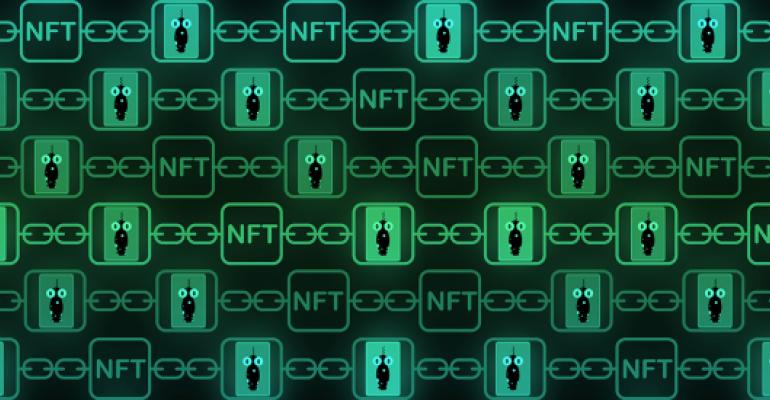If you’ve been paying attention to the news, you’ve likely seen this three letter acronym plastered across every major outlet: NFT. But what exactly does it mean? An NFT, or a non-fungible token, is a unique digital token that securely stores information on a blockchain. In other words, NFTs are one-off digital assets such as videos, images, memes, art pieces, badges, and virtual clothing, among others, that can be purchased through a cryptocurrency site or simply with your credit card.
But first, let’s look at the history of NFTs.
It was an artist named Beeple who was the first to make a major sale of NFTs, which completely rocked the arts and cryptocurrency world—$69M for a JPEG of a painting that had yet to be made.
Beeple’s PSA regarding the sale read as follows:
“NOTES: This piece is a first for Nifty [Gateway], a token that will change based on the outcome of the election. If anything is constant about the times we now live in, it’s uncertainty. This uncertainty is perfectly encapsulated in this piece of artwork as the person buying the piece will not know the final artwork. The artwork will be one state at auction before the election, and after the results of the election are known, will forever change to reflect a Trump or Biden win”
As we look forward from where NFTs began, it is evident that NFTs will soon become entrenched in live, virtual, and hybrid events as these certificates of authenticity become a favorite among artists. Messari analyst Mason Nystrom predicts the NFT market will surpass $1.3 billion by the end of 2021.
The Special Event, co-located with The Catersource Conference & Tradeshow, is heading to Miami July 19 – 22, 2021. Immerse yourself in an inspiring and safe event focused on the new trends and opportunities in events and catering. Learn more
No matter your knowledge of cryptocurrency, you can start applying NFTs at your events through downloads, discounts, redeeming customized swag, and gamification elements. Here are a few key elements to keep in mind when thinking about NFTs.
Ticketing
Traditional ticketing processes are flawed with high costs, inauthenticity, and limited options for customizing landing pages, tickets, and confirmation emails. Ticketing sites such as Eventbrite can have set costs and typically take a high percentage of each ticket sold. However, building and minting NFTs can be created for less than a couple dollars if structured correctly, which is miniscule compared to traditional ticketing infrastructure.
Since the ticket’s code lives on the blockchain, NFTs make authentication and changes simple. On average, 12% of people buying concert tickets get scammed. With NFTs, you have the option to make tickets non-transferable in computer code and prevent the transfer of tickets and resale fraud.
In the same vein, cloud-based ticketing allows for remote updates. You are able to transfer tickets and authenticate with absolute certainty. Computer programmable ticketing has been around for years, but as we’ve seen with the pandemic, the ability to quickly update your event info is increasingly valuable.
Downloads
Accurately capturing attendee information has never been easier with one-time downloads. Guests are able to walk up to a booth, scan a unique QR code, enter their contact information, and collect personalized marketing materials that will live on their device instead of the trash. Due to no-touch COVID preventative measures, QR codes have already become fairly common at events, bars, and restaurants.
Swag
One-off digital assets can also be used to sell rare virtual swag. Promotional materials for events have proven to be a great way to increase brand awareness, support company culture, and incentivize guests and employees. NFTs as virtual swag helps mitigate shipping costs, follows sustainability initiatives, and ensures each gift is completely unique.
Effective product marketing happens when people are excited and proud to wear or use that item. Swag signifies your time spent and involvement with the company: a shirt from the first ever company picnic, an award for exceeding sales goals, memorabilia from past conventions; you could sit on Zoom wearing that shirt with the award memorabilia just within camera view, but that would look a little ridiculous. In a virtual and hybrid world, we have to rethink how we show our teams and attendees recognition, and the whole thing about NFTs is scarcity. Custom digital badges, GIFs, virtual clothes and awards in addition to tangible mailers elevates the experience while translating to virtual and hybrid experiences.
Gamification
Gamification is essentially applying game theory to experiences that aren’t a game–adding incentive to the customer journey. Monetizing humans’ natural competitiveness isn’t a fairly new trend with events, but figuring out how to do that virtually is now at the forefront of event planners' minds.
Creating an affinity with a brand is easy when you’re rewarded with your engagement and you’ve likely already encountered gamification in your daily life. Enter your email, spin the wheel, receive a discount; sound familiar?
Incentivize attendee engagement by gamifying your virtual event content. Have attendees participate in a virtual scavenger hunt where they collect hidden “gems” around the event and whoever collects the most wins a 1:1 session with a keynote speaker. This trend is especially popular among experiential brand activations and product launches where collectables are highly sought after.
There’s still a lot to learn about NFTs, but maybe this will start you thinking about how they can work to your benefit.





